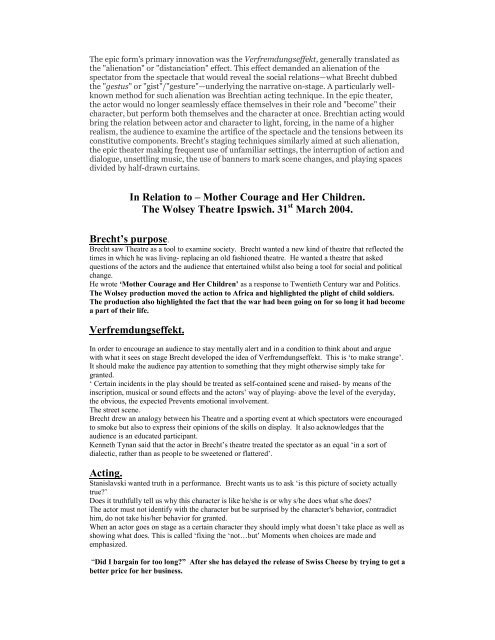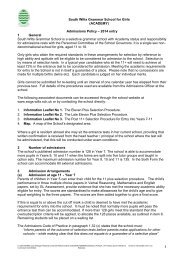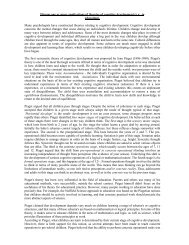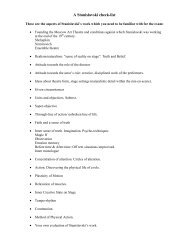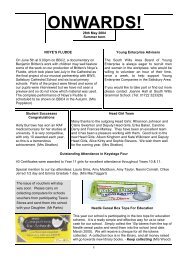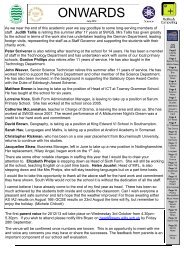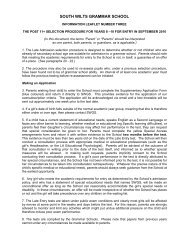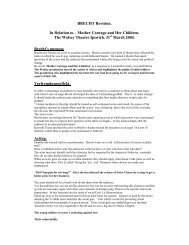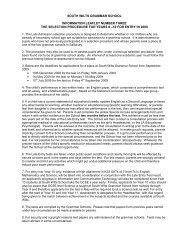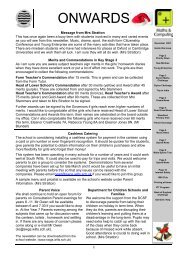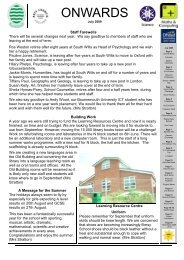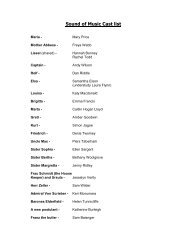The Epic form style and staging
The Epic form style and staging
The Epic form style and staging
Create successful ePaper yourself
Turn your PDF publications into a flip-book with our unique Google optimized e-Paper software.
<strong>The</strong> epic <strong>form</strong>'s primary innovation was the Verfremdungseffekt, generally translated as<br />
the "alienation" or "distanciation" effect. This effect dem<strong>and</strong>ed an alienation of the<br />
spectator from the spectacle that would reveal the social relations—what Brecht dubbed<br />
the "gestus" or "gist"/"gesture"—underlying the narrative on-stage. A particularly wellknown<br />
method for such alienation was Brechtian acting technique. In the epic theater,<br />
the actor would no longer seamlessly efface themselves in their role <strong>and</strong> "become" their<br />
character, but per<strong>form</strong> both themselves <strong>and</strong> the character at once. Brechtian acting would<br />
bring the relation between actor <strong>and</strong> character to light, forcing, in the name of a higher<br />
realism, the audience to examine the artifice of the spectacle <strong>and</strong> the tensions between its<br />
constitutive components. Brecht's <strong>staging</strong> techniques similarly aimed at such alienation,<br />
the epic theater making frequent use of unfamiliar settings, the interruption of action <strong>and</strong><br />
dialogue, unsettling music, the use of banners to mark scene changes, <strong>and</strong> playing spaces<br />
divided by half-drawn curtains.<br />
In Relation to – Mother Courage <strong>and</strong> Her Children.<br />
<strong>The</strong> Wolsey <strong>The</strong>atre Ipswich. 31 st March 2004.<br />
Brecht’s purpose.<br />
Brecht saw <strong>The</strong>atre as a tool to examine society. Brecht wanted a new kind of theatre that reflected the<br />
times in which he was living- replacing an old fashioned theatre. He wanted a theatre that asked<br />
questions of the actors <strong>and</strong> the audience that entertained whilst also being a tool for social <strong>and</strong> political<br />
change.<br />
He wrote ‘Mother Courage <strong>and</strong> Her Children’ as a response to Twentieth Century war <strong>and</strong> Politics.<br />
<strong>The</strong> Wolsey production moved the action to Africa <strong>and</strong> highlighted the plight of child soldiers.<br />
<strong>The</strong> production also highlighted the fact that the war had been going on for so long it had become<br />
a part of their life.<br />
Verfremdungseffekt.<br />
In order to encourage an audience to stay mentally alert <strong>and</strong> in a condition to think about <strong>and</strong> argue<br />
with what it sees on stage Brecht developed the idea of Verfremdungseffekt. This is ‘to make strange’.<br />
It should make the audience pay attention to something that they might otherwise simply take for<br />
granted.<br />
‘ Certain incidents in the play should be treated as self-contained scene <strong>and</strong> raised- by means of the<br />
inscription, musical or sound effects <strong>and</strong> the actors’ way of playing- above the level of the everyday,<br />
the obvious, the expected Prevents emotional involvement.<br />
<strong>The</strong> street scene.<br />
Brecht drew an analogy between his <strong>The</strong>atre <strong>and</strong> a sporting event at which spectators were encouraged<br />
to smoke but also to express their opinions of the skills on display. It also acknowledges that the<br />
audience is an educated participant.<br />
Kenneth Tynan said that the actor in Brecht’s theatre treated the spectator as an equal ‘in a sort of<br />
dialectic, rather than as people to be sweetened or flattered’.<br />
Acting.<br />
Stanislavski wanted truth in a per<strong>form</strong>ance. Brecht wants us to ask ‘is this picture of society actually<br />
true?’<br />
Does it truthfully tell us why this character is like he/she is or why s/he does what s/he does?<br />
<strong>The</strong> actor must not identify with the character but be surprised by the character's behavior, contradict<br />
him, do not take his/her behavior for granted.<br />
When an actor goes on stage as a certain character they should imply what doesn’t take place as well as<br />
showing what does. This is called ‘fixing the ‘not…but’ Moments when choices are made <strong>and</strong><br />
emphasized.<br />
“Did I bargain for too long?” After she has delayed the release of Swiss Cheese by trying to get a<br />
better price for her business.
<strong>The</strong> actor should not let a fourth wall divide them from the audience.<br />
‘Let the audience see you are not this character, but you are an actor representing this character <strong>and</strong> that<br />
you do not necessary agree with what your character is doing/saying. However be specific <strong>and</strong> avoid<br />
characature. In this last point are the seeds of social Gest. I.e Demonstation.<br />
Emotions have to be externalised <strong>and</strong> for this an actor must use gesture. Gesture as used by the actors<br />
adopting the V-effekt must underline the social gest. ‘ One which reveals the prevailing social<br />
relationships between people of a given period. <strong>The</strong>se social gests are underlying every incident.<br />
Absolute clarity was very important to Brecht <strong>and</strong> he was a big fan of Charlie Chaplin.<br />
<strong>The</strong> young soldiers in scene 1 urinating against tree<br />
<strong>The</strong>ir vulnerability<br />
Reading Playboy.<br />
Mother Courage always carefully counted out the money when doing a deal.<br />
<strong>The</strong> General- his laugh <strong>and</strong> cigar <strong>and</strong> his swagger.<br />
Yvette- her body language <strong>and</strong> costume- westernized <strong>and</strong> blonde wig.<br />
Later when Yvette was married to the Colonel she got fatter <strong>and</strong> wore fur coat. <strong>The</strong> colonel was<br />
also padded out so that he burst out of his shirt.<br />
Direct address to the audience- <strong>The</strong> chaplain directly addressed the audience <strong>and</strong> asked them to<br />
think about Eilif being a hero during wartime but a criminal for doing the same in peace.<br />
Brecht wanted us to be critical of the people he made fun of - <strong>The</strong> General, <strong>The</strong> Chaplain,<br />
Exaggeration used to ridicule.<br />
<strong>The</strong> use of the Death Dance’s as a distancing effect.<br />
Dancing with guns was an expression of attitude.<br />
Set Design<br />
Brecht’s most famous set Designer was Casper Neher. Neher would observe rehearsals <strong>and</strong><br />
concentrated on social groupings. <strong>The</strong> set should remind the spectator that they are in the theatre <strong>and</strong><br />
should acquire the same fascinating reality of a sporting arena during a boxing match- to show the<br />
machinery.<br />
During the per<strong>form</strong>ance you had to cross the stage to exit the auditorium. <strong>The</strong> atmosphere of the<br />
production was such that audience members felt able to speak aloud their comments on the<br />
action.<br />
“ If a set represents a town it must look like a town that has been made to last precisely 2 hours”<br />
Selective Realism- Using only what is necessary to tell the story <strong>and</strong> should be authentic.<br />
Scene 11 used the wagon for Kattrin to sit on rather than a roof.<br />
Tents made from canvas but in scene 2 it was just a canopy <strong>and</strong> the General <strong>and</strong> Chaplain <strong>and</strong><br />
Eilif stood outside of it.<br />
Authentic uni<strong>form</strong>s <strong>and</strong> costumes<br />
Guns<br />
Chicken in scene 2
Potatoes in scene 2<br />
Chaplain chopping wood.<br />
Brecht saw the set as another actor <strong>and</strong> often the set could be constructed in such away as to force an<br />
actor into adopting an attitude. It adds to the gestus.<br />
In Scene 2 <strong>The</strong> General was stood up stage left <strong>and</strong> had a large gr<strong>and</strong> straight backed chair.<br />
Stage right the cook was on a very small milking stool whilst he peeled the potatoes. MC had to<br />
crouch down beside him to pluck the chicken.<br />
<strong>The</strong> cart was heavy <strong>and</strong> difficult to manoeuvre the actors’ were forced to show the struggle to<br />
move it <strong>and</strong> get around.<br />
Songs<br />
Music was an essential part of Brecht’s <strong>The</strong>atre. It could interrupt the action, comment on the action<br />
<strong>and</strong> could comment on emotions in the 3 rd person. Song of fraternization- song by Yvette.<br />
Songs were to be treated as separate elements. Courage’s song about how war is just another <strong>form</strong> of<br />
business.<br />
Courage’s song scene 7- Glitter ball, Marlene Dietrich, Fur coat <strong>and</strong> diamonds, KERCHING.<br />
Breaks up the structure Non linear.<br />
Spass<br />
A sense of fun.<br />
<strong>The</strong> scene changes- had a real sense of energy.<br />
<strong>The</strong> radio announcement <strong>style</strong> of the original scene titles.<br />
Comedy as a distancing technique. Swiss cheese’s death <strong>and</strong> the Man U gag <strong>and</strong> scene 11 which<br />
has always been a tricky scene for directors was stopped from being emotional by the singing of<br />
“Lady In Red” <strong>and</strong> “Agadoo” but was still powerful.<br />
Comic characterizations.<br />
<strong>The</strong> chaplain’s vest having bullet holes in the shape of a cross<br />
.<br />
Jokes relating to Nigeria<br />
<strong>The</strong> chaplain’s proposal to Mother Courage- <strong>The</strong> chopper!<br />
Montage.<br />
Connects dissimilars in such away as to ‘shock’ people into new recognition’s <strong>and</strong> underst<strong>and</strong>ings.<br />
<strong>The</strong> image on the slide at the end mirroring MC’S gesture.<br />
Eilif’s death on stage as MC sings another verse of courage’s song.<br />
Scene titles<br />
Help eliminate suspense.
<strong>The</strong> play’s lengthy scene titles were delivered by radio announcements.<br />
Captions on cyclorama showed how many years had passed <strong>and</strong> drew attention to the fact that<br />
the play is a story <strong>and</strong> set in the past.<br />
Use of images. <strong>The</strong> child soldier before the interval made the audience focus on the message of<br />
the play. <strong>The</strong> image of the guns with MC at the end. <strong>The</strong> war is just another business trading in<br />
blood instead of boots.


